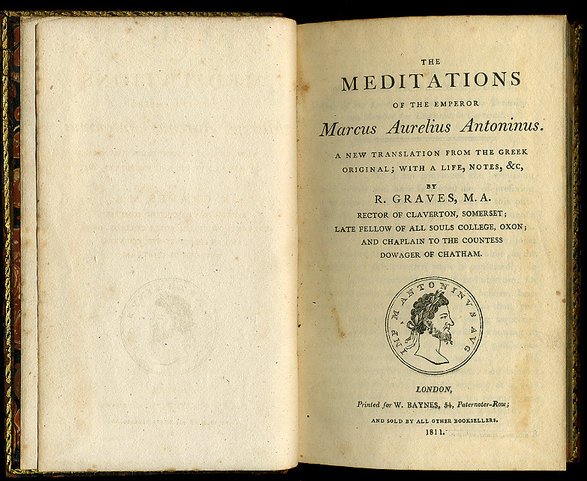Journaling has become quite a popular practice in the general field of self-help. But don’t be surprised to find that journaling is also very useful for aspiring Stoics.
From becoming more disciplined to increasing general happiness in life, keeping a Stoic journal is a great idea for anyone striving to become a better person.
In this article, let’s take a look at how you can journal like a Stoic, as well as some benefits of keeping a Stoic journal.
Contents
How to Journal Like a Stoic
If you find it surprising that journaling could be a useful part of Stoicism, then look no further than Meditations.
A copy of Meditations from the 1800s
Meditations was Marcus Aurelius’s Stoic journal, which was never meant to be published. And yet this journal comprised of a series of ‘note to selves’ has become one of the most influential texts in Stoicism.
Marcus Aurelius kept a journal to remind himself of how to live a virtuous life. But it is more than that, keeping a Stoic journal could also help you handle setbacks, take risks, or even make you happier.
So here are four methods of Stoic journaling that can help you become a better Stoic and person.
All of the following methods of keeping a Stoic journal could be done in your mind. But it is far more effective to write them down.
Morning Preparation Journaling
“When you wake up in the morning, tell yourself: the people I deal with today will be meddling, ungrateful, arrogant, dishonest, jealous and surly. They are like this because they can’t tell good from evil. But I have seen the beauty of good, and the ugliness of evil, and have recognized that the wrongdoer has a nature related to my own – not of the same blood and birth, but the same mind, and possessing a share of the divine. And so none of them can hurt me. No one can implicate me in ugliness. Nor can I feel angry at my relative, or hate him.” – Marcus Aurelius
It is inevitable that something will go wrong in any given day. It could be anything from a minor inconvenience to a major setback.
If you are familiar with the Stoic concept of the Dichotomy of Control, then you know the only thing we can do when things go wrong is to react in the most appropriate manner, without frustration or anger.
But it can be difficult to act like a Stoic when misfortune catches you off guard. This is where morning preparation journaling can become useful.
To practice morning journaling like a Stoic, all you have to do is spend a couple of minutes each morning writing down all the things that could go wrong in your day.
Just like the quote above from Meditations, Marcus Aurelius did this by writing down all the negative qualities people could exhibit, and reminding himself that none of them could hurt him or make him feel angry.
As long as you have a rough idea of what your day looks like, then it shouldn’t be difficult to think of all the parts of your day that could go wrong.
If you have an important meeting, a presentation, an exam, or a date, those are all the things you can write down as possible encounters with misfortune.
You could be late, forget a part of your presentation, mess up your exam, or get diarrhea in the middle of a date.
Any of these things would take less than a minute to write about. Once you have written the things that could go wrong, remind yourself that it won’t be a big deal.
By writing down all the potential adversities and obstacles you may encounter in your day, you are preparing your mind to handle such events.
And when the inevitable mishap happens, it will be easier to go into problem-solving mode or accept it with equanimity, instead of sulking about it.
Don’t worry. This won’t make you a negative person. But it will keep the fact that anything could happen in the back of your mind.
The more you make this a part of your Stoic journaling routine, the more effective it will be. You will be able to react to anything that befalls you with calm when everyone else might start to panic.
Nightly Reflections Journaling
“When the light has been taken away and my wife has fallen silent, aware as she is of my habit, I examine my entire day, going through what I have done and said. I conceal nothing from myself, I pass nothing by. I have nothing to fear from my errors when I can say: ‘See that you do not do this anymore. For the moment, I excuse you.’ ” – Seneca
If you wish to become a better person, first, you need to be aware of your faults; that is what nightly reflections are for.
At the end of each day, ask yourself these three questions:
- What did I do well today?
- What did I do not so well today?
- What could be improved?
To answer each question, go through your day in your mind and consider all of your actions throughout the day.
Think about when you’ve continued a good habit, or reacted to something rationally instead of acting out. Also, consider the times when you continued a bad habit or let your emotions get the better of you.
Then think about what aspect of your actions/character you could improve. It could be anything from not snoozing in the morning, to being more honest and having the courage to say no.
You can write as many answers to each of the three questions as you like. But to prevent making this into too much of a chore, one or two answers for each question is enough.
Five to ten minutes is all you need for nightly reflections. If you have extra time, you can also write down strategies you can use to help improve the particular aspect of your character.
By doing this exercise, you will become more mindful throughout your day to not repeat the bad habits and to continue the good ones. And before you know it, you would have fixed many flaws that you once thought was an irreparable part of you.
If you continue this habit for months or even years, you will also be able to read through old entries and see how far you have come since then.
“Compare yourself to who you were yesterday, not to who someone else is today.” – Jordan Peterson
It is also crucial that you don’t judge yourself too harshly when doing nightly reflections in your Stoic journal.
It’s okay to hold yourself to a high standard, but you must also be unbothered by your flaws. Understand that in order to improve and become better, there must be something to improve upon.
Fear Setting
“If you would not have a man flinch when the crises comes, train him before it comes.” – Seneca
Negative visualization is a tried and true Stoic exercise that builds resilience and perspective.
There are many forms of negative visualization; this journaling variation of the exercise is also called fear setting.
Fear setting is a method of conquering your fears by defining them. Unlike the previous two Stoic journaling methods, fear setting is not a daily exercise. It is only done once in a while or when there is something you’re unsure about pursuing.
Here’re the four steps of fear setting:
Step 1 – Write down the thing you’re unsure about doing. It could be anything from asking someone out, to quitting college to work on a startup.
Step 2 – Write down what’s the worst that could happen. You could get rejected, or your startup could fail after spending a ton of time and money on it.
Step 3 – Write down what you could do if the worst-case scenario happens. If you get rejected, you could simply move on with your life. If your startup fails, you could go back to school or take what you’ve learned and work on a new startup. It might set you back a couple of years, but you will be okay.
Step 4 – Write down what’s the best-case scenario. The person you ask out says yes. Your startup succeeds.
Fear setting can be tremendously helpful when you’re unsure about taking a risk in life.
By following the four steps, you will often realize that the worst-case scenario is not that bad, and the best-case scenario is worth the risk.
Fear setting takes a lot longer to do than the previous two methods of Stoic journaling, but it can give you the courage to take necessary leaps of faith in life.
Moreover, it can also prepare you for the worst-case scenario. And when it happens, you will know what to do instead of panicking.
Because of its benefits, you should be as specific as possible when following the four steps of fear setting. Especially for step 3, the more specific your plan is when things don’t go your way, the more prepared you will be to handle such adversities.
Gratitude Journaling
“Do not dream of possession of what you do not have: rather reflect on the greatest blessings in what you do have, and on their account remind yourself how much they would have been missed if they were not there.” – Marcus Aurelius
The Stoics understood that gratitude is an essential part of happiness.
In today’s society, people often believe that happiness is something to be pursued, something you get once you’ve achieved a certain goal or bought a particular product.
For anyone who believes in the “pursuit of happiness”, they will eventually achieve their milestone in life only to find that happiness doesn’t reside there.
Then they will look for happiness in the next one. But they will find none.
“Happiness cannot be puresued; it must ensure.” – Viktor Frankl
Instead, you should look within yourself for happiness, because it is not determined by any external factor.
One of the most effective ways of “obtaining” happiness is through gratitude.
Unless you are the unluckiest person on the planet, you will have something that someone doesn’t, something perhaps someone believes to be their key to happiness. It could be anything from a clean source of water to a family.
By being grateful for these things in life, you will realize that you have much more than you thought, and there is no reason to be unhappy.
Here’re two ways you can incorporate gratitude into your Stoic journal.
1. When you’re writing down all the potential mishaps that could happen in your day, also write down some things you are grateful for in your life.
2. Once a month, block out some time to think about what you are grateful for in your life and write it down.
You could be grateful for anything and everything.
It could be a past relationship you’ve had, your job, your friends, etc. It could even be the weather, the bed you sleep in, or your access to hot showers.
You could also be grateful for past adversities because they made you the person you are today. Or current ones because they are opportunities for virtue.
There are also tools such as the 5-minute journal app that can help you with gratitude journaling.
To learn more about Stoics exercises that are just as useful as Stoic journaling, check out our free 7 Stoic Exercises guide:



























